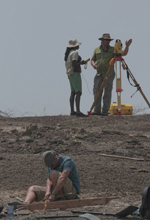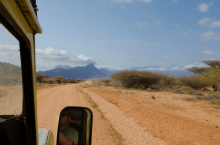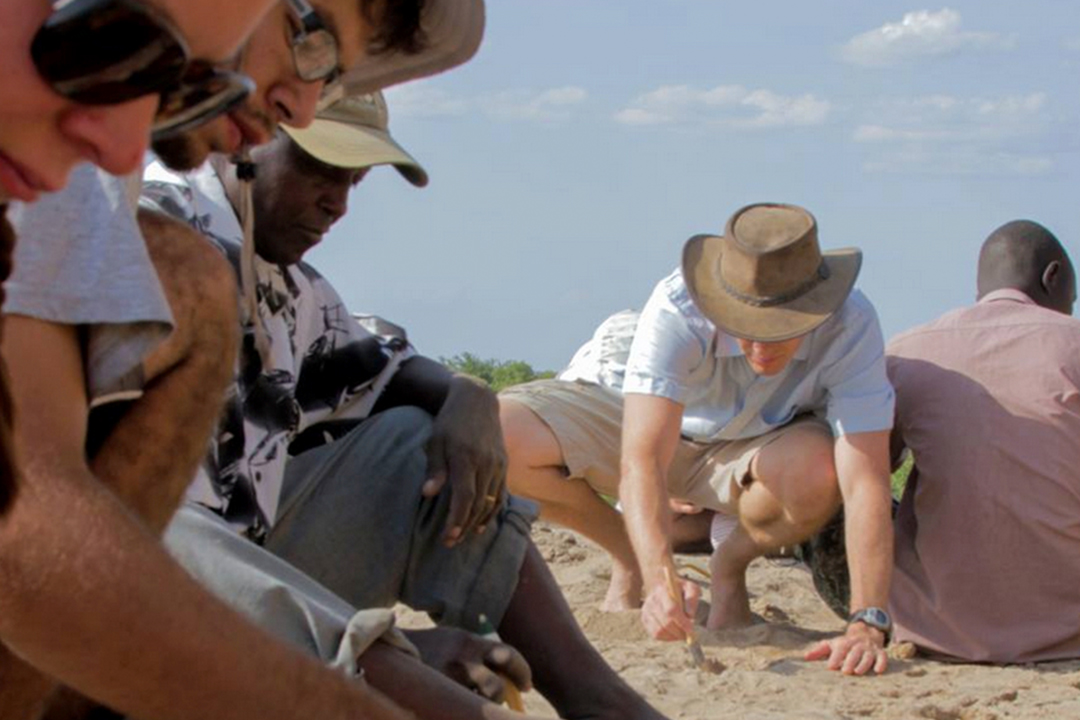So you want to be an archaeologist? Leave your Indiana Jones fantasies at home. At the Koobi Fora Field School in Kenya, students get their hands dirty. They dig wells, battle 120 degree heat, dodge scorpions and . . . sift through a fossil field full of dreams.
“If you can make it six weeks in Koobi Fora, you can do anything.” said David Braun, assistant professor of Anthropology. “Our kids come here as students. By the time they’re done, we expect them to be scientists.”
Last summer, Columbian College graduate student Beccy Biermann and undergraduate student Roma Padalkar were among the dozen students from universities around the world who lived and worked in one of the most remote regions on the planet as participants in the Koobi Fora Field School. The six-week educational experience combines lectures and labs with hands-on field work. A collaborative effort between the National Museums of Kenya and Columbian College’s Center for the Advanced Study of Human Paleobiology, the school is the world’s premier international paleoanthropology training operation.
An ‘Adventure of a Lifetime’
When Biermann, whose graduate work is in anthropology, left her hotel in Nairobi for the 500-mile trek to Koobi Fora, she brought only a small tent, a backpack stuffed with hiking boots, water bottles, a handful of granola bars and a tube of 70-proof sunscreen. Where she was going, that’s all she would need.
At 22, Biermann is well-travelled. She was born in Germany, vacationed in Jordan, and studied anthropology in Mexico. But none of those experiences prepared her for what was to come. During that first day in the truck, as she bounced on dirt roads, she watched the landscape transform around her — from the lush foothills of Mount Kenya to the rolling savannahs of the Great Rift Valley to the barren deserts of eastern Africa.
“You’re traveling in this tight space with all these sweaty strangers,” Biermann said. “You’re hot and thirsty and covered in dirt. You’re driving for day-after-day. There is a part of you that thinks, ‘What did I get myself into?’”
Finally, after four days, the truck barreled over a rocky hill, and Biermann gasped at one of the most dramatic sights on the planet: The fierce red African sun setting over the jade Lake Turkana. “It was the most beautiful thing I’d ever seen,” Biermann recalled. “That was the moment I knew I’d made the right decision. This was going to be the adventure of a lifetime.”
Far removed from the modern world, Koobi Fora is among the most important cradles of human development ever explored. Its sandstone ridge yields some of the earliest evidence of mankind’s ancestors, from Homo Erectus to Australopithecine. Researchers in the fossil-rich region have uncovered footprints, teeth, bones and stone flakes that date as far back as two million years.
“This is where the discoveries are being made,” Braun said. “It’s one of a handful of the most significant archeological spots in the world.”
 From classrooms to excavation sites, the students worked side-by-side with world-class archeologists. “We weren’t just getting knowledge about time periods and artifacts; we were also out there picking up skills,” said Biermann. “We were learning how to be archeologists.”
From classrooms to excavation sites, the students worked side-by-side with world-class archeologists. “We weren’t just getting knowledge about time periods and artifacts; we were also out there picking up skills,” said Biermann. “We were learning how to be archeologists.”
For many students, the remote African experience was their first time away from their families and—with no electricity, running water, or phone service—far from their normal comfort zone. “This isn’t another world,” Braun said. “It’s another universe.”
Roma Padalkar had her reservations about traveling to Koobi Fora. A biological anthropology and public health major, archeology wasn’t even her primary interest. Most field school students focus on paleoanthropology, a sub-discipline of anthology that explores evidence of human evolution.
“I’m more into learning how different cultures work than finding skulls,” she said. “Applying to Koobi Fora was like a crazy dream.”
Padalkar, a New Jersey native, and Biermann, were two of 50 applicants seeking a coveted spot in the field school class. Only 20 are accepted per session, chosen from American schools and schools in Kenya, Ethiopia and South Africa. After Padalkar was accepted, she barely had time to schedule her yellow fever immunization and pick up her anti-malarial meds—much less wonder if she’d made the right decision—before catching a flight for Kenya.
Sand, Sand Everywhere
At dawn in Koobi Fora, the sun shoots into the sky like a rocket. The region is so close to the equator that night turns to morning in seconds. Padalkar stumbled from her tent on that first morning, already covered in sand. “There was sand in my backpack, sand in my hiking boots, sand everywhere,” she said.
This isn’t “archeology chic,” added Padalkar. You won’t find many Koobi Fora students in cargo shorts and Indiana Jones-fedoras. The dress code runs closer to gym shorts, tank tops and a scarf to string between branches for a few precious feet of shade.
Breakfast at Koobi Fora was a mix of porridge and corn flakes. Or students chowed down a carb-laden concoction that they dubbed Field School Stew. “I’m not really sure what it’s made of,” Padalkar said. “Rice, beans, potatoes, whatever they can throw in the pot.” She expected to gain weight on the diet of starches, canned good, and beef jerky. Instead, she sweated off 12 pounds.
Through the course of the session, the students split their time between locations. The first stop was a private game range on the edge of the Rift Valley. For a week, the students camped in an open conservancy and experienced life on the African savannah, complete with the roar of lions and leopards in the distance. Next, the crew settled into a base camp in the shadow of Lake Turkana. Known as the Jade Sea for its incandescent glow, Turkana stretches over 250 kilometers, longer than the entire Kenyan coast. It’s the site of the original Koobi Fora settlement established by famed explorer Richard Leakey in the late 60s. Base camp offered a forum for lectures and classroom work—as well as field showers and laundry in the lake.
“At best, you get what we call ‘field clean,’” Biermann said. “You wash off the sweat, but there’s a layer of slime and sand that never goes away.”
More Than Digging in the Dirt
From base camp, the students and instructors hiked deeper into the desert for field work. Their research topics took them to the barren Kurari desert and an arid wasteland near the Ethiopian border called Ileret.
“A lot of people think field schools are for hanging out in the summer and digging in the dirt,” Braun said. “Ours wasn’t really like that. This is an apprenticeship. If you come here, you are an active participant in important research.”
Biermann’s studies focus on early man’s stone tools. While scouting alone through Ileret, she stumbled across a field of tool flakes that were likely untouched for two million years. “They were literally crunching under my boots,” she said. “There’s an incredible feeling of freedom when you are out by yourself in the middle of nowhere and your teachers trust you to do your own research. It’s very empowering.”
Padalkar’s project brought her in contact with the Daasanach, Turkana’s agro-pastoralist tribe of livestock herders. With an interpreter, Padalkar ventured into the tribal community to observe their lifestyle and traditions. The school and the tribe have even forged an annual tradition. On the Fourth of July, the Daasanach invite the school team to a dance, a tribal custom that celebrates friendship and marriage. First, the Daasanach perform jump-style dances to drums and vocals. The students respond with their own hip-hop moves to music piped over Landrover speakers.
“How else would I get an opportunity to immerse myself in a totally different culture and a new way of life,” Padalkar said, “and have fun at the same time?”
Passion and Perseverance
 For Braun, the dedication of the Koobi Fora students is as impressive as the landscape. “These kids could spend the summer sitting on a beach with their friends,” he said. “Instead they are out here because they are really passionate about this work.”
For Braun, the dedication of the Koobi Fora students is as impressive as the landscape. “These kids could spend the summer sitting on a beach with their friends,” he said. “Instead they are out here because they are really passionate about this work.”
The students themselves say they learn skills that go beyond archeology, from re-wiring a truck’s drained battery in the punishing sun to blocking out the snores of the classmate in the next tent. Students become accustomed to wearing close-toed shoes at nigh—the best way to fend off scorpions burrowing in the sand. Occasionally, the remote outpost produced more serious issues. A Medevac crew is available to transport a student out of Koobi Fora, but it’s a one-way trip. “In an emergency, we can get you out, but we can’t get you back,” Braun noted.
Biermann reached her lowest point when the field diet sparked a gluten-allergy reaction. “That was the only time where I thought I might not make it,” she recalled. “That’s when I thought a bed and a toilet would look pretty good.”
And while the blistering heat and close quarters did fray some nerves, the strong bond forged among participants is evident. “We’ve even had a few field school marriages,” said Braun, who met his own wife on a Koobi Fora dig.
By the time the students load up the truck for the trip back home, there are few doubts about whether they are following the right career path. “We rate our success by how many students go into anthropology, whether they choose paleoanthropology or something like public health,” said Braun. “Very few people walk away from here and discover they want to be hedge fund managers.”
To many, the ride out of Koobi Fora is more emotional than the journey in. There are often more sighs of sadness than relief. “I miss it,” Biermann said. “I was so lucky to be there. It solidified my decision. This is what I want to do with the rest of my life.”


